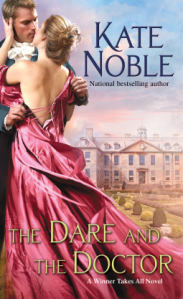 Kate Noble writes romance of complexity and thought. And her most recent The Dare and the Doctor is wrought in this vein: thoughtful, with nuanced characters caught in believable dilemmas, and with growing feelings of love for the wrong person. Miss Bates admits that, while she enjoyed the novel in its entirety, prose and characterization and plot, her favourite part was the opening section for its epistolary nature. Miss Margaret Babcock of Lincolnshire, horticulturist extraordinare, she of rose cross-breeding fame, found a friend and kindred spirit in Dr. Rhys Gray, former army surgeon and now Greenwich-based, when he attended her father at their estate and relieved him of his gout. Since, and serving in a marvelous series of exchanged letters, Margaret and Rhys have enjoyed a close, warm, and witty correspondence, deepening and growing their friendship. Knowing that Margaret’s dream is to present her prize roses to the Horticultural Society, Rhys arranges for her to meet with them in London. Margaret travels to London to stay with their mutual friends, Lord Ashby, Ned; wife, Phoebe; and cherubically fun six-month-old, Edward. Rhys, in turn, travels from his Greenwich laboratory to London to reconnect with old and dear friends Ned and Phoebe and see Margaret.
Kate Noble writes romance of complexity and thought. And her most recent The Dare and the Doctor is wrought in this vein: thoughtful, with nuanced characters caught in believable dilemmas, and with growing feelings of love for the wrong person. Miss Bates admits that, while she enjoyed the novel in its entirety, prose and characterization and plot, her favourite part was the opening section for its epistolary nature. Miss Margaret Babcock of Lincolnshire, horticulturist extraordinare, she of rose cross-breeding fame, found a friend and kindred spirit in Dr. Rhys Gray, former army surgeon and now Greenwich-based, when he attended her father at their estate and relieved him of his gout. Since, and serving in a marvelous series of exchanged letters, Margaret and Rhys have enjoyed a close, warm, and witty correspondence, deepening and growing their friendship. Knowing that Margaret’s dream is to present her prize roses to the Horticultural Society, Rhys arranges for her to meet with them in London. Margaret travels to London to stay with their mutual friends, Lord Ashby, Ned; wife, Phoebe; and cherubically fun six-month-old, Edward. Rhys, in turn, travels from his Greenwich laboratory to London to reconnect with old and dear friends Ned and Phoebe and see Margaret.
Through the epistolary wit and warmth of Rhys and Margaret’s letters, Miss Bates delighted in the hero and heroine’s introverted natures. Witness some of their exchanges: Rhys: “I too am glad I came back from war. It relieved me of my desire to travel, and I find myself happier and more at home in my laboratory than anywhere else.”; Margaret: “I think it best if I continue spending my winter trying to graft roses. I make my own fun.” There is nothing more attractive, at least to Miss B., than self-contained, self-entertaining, absorbed-in-their-work protagonists who find love in each other. It bodes well for their future lives: together and apart, happy at work and love. Before our Margaret and Rhys can achieve connubial bliss, they must suffer, otherwise this isn’t a romance but an idyll and idylls are not what the genre is about. Suffering comes in the form of, in true introverted fashion, other people, namely Rhys’s large, amusing, but selfishly demanding family, “His troubles, which took the form of two brothers, three sisters, a nephew, a mother, and a dog older than dirt” – and one Rosamond-née-Vincy-Lydgate-like near-fiancée, Miss Sylvia Morton.
Sadly, there is an “understanding” between the Grays and Mortons. When the plebeian nouveau-riche Mortons moved into the Grays’ neighbouring estate, Lord Bellamy Gray, Rhys’s arrogant wastrel father, fought a duel with Mr. Morton, injuring him. Lord Gray was then compelled to leave the country with Rhys’s elder brother, Francis. Rhys’s mother wants Rhys to marry Miss Morton, thus ensuring Mr. Morton’s pardon and Lord Gray’s and fils’s return to hearth, home, and family. Alas, Rhys is temperamentally, physically, and spiritually linked to Margaret. Noble has truly rendered two characters who are most suited to each other. But Rhys dearly loves his flawed family and cannot bring himself to deny his mother’s wishes. As a result, Miss Morton plays sly third fiddle to Rhys and Margaret and foils their romance time and again. Noble has managed to write a great “Other Woman” character in Sylvia, without making her caricaturish, anymore than Eliot’s great portrayal of self-absorption and moral expediency, Rosamond Vincy-Lydgate, is simplistic.
Having read and reviewed Noble’s The Game and the Governess, whose hero and heroine we encounter in The Dare and the Doctor as Rhys and Margaret’s friends, Ned and Phoebe, one thing Miss Bates must say for Noble is that she has a wonderful capacity to make her heroines incredibly strong and strong in their vulnerability while heroes flounder on moral grounds. Rhys wants Margaret with his heart, soul, and body, she is truly is “other half,” but he’s willing to sacrifice his happiness, and as a consequence, Margaret’s, on the altar of family loyalty, love, and obligation. But Rhys is also an incredibly honourable and giving sort, he cannot be giving towards his family and be less than the best of friends to Margaret. So, when Margaret is beset by the London ton‘s social whirl, he sets her free to tend her roses and build a garden-conservatory for Ned and Phoebe by saying to her, ” ‘Tell Sylvia and Phoebe you need to spend the next few days in. You’re not receiving.’ She met his eyes. ‘You have that right,’ he whispered. ‘Everyone has the right to themselves.’ ” Ah, Rhys, the reader thinks, “You speak as much about yourself as you do Margaret.” In the end, however, with Noble’s gift for a strong heroine, Margaret sets Rhys free to love and be himself.
Kate Noble’s The Dare and the Doctor is a wonderful friends-to-lovers romance, rendered in a historical period more difficult to achieve than in contemporary romance. When Rhys finally proposes to Margaret, he says: ” ‘Will you marry me, my very best of friends?’ ” The journey to this point is fraught, with Rhys being pulled in so many directions of love and obligation that he forgets the one “thing needful,” the love and happiness of the person who most completes him and, in turn, his own. The Dare and the Doctor is a lovely romance, maybe Noble could’ve “let go” of some of its length (it dragged in places), but it’s a minor quibble. With Miss Austen, who would’ve enjoyed Noble’s romance, Miss Bates says it shows evidence of “a mind lively and at ease,” Emma.
Kate Noble’s The Dare and the Doctor is published by Simon and Schuster’s Pocket Books. It was released in November 2016 and may be found at your preferred vendors. Miss Bates received an e-ARC from Pocket Books, via Netgalley.
Rate this:Share this:- More






